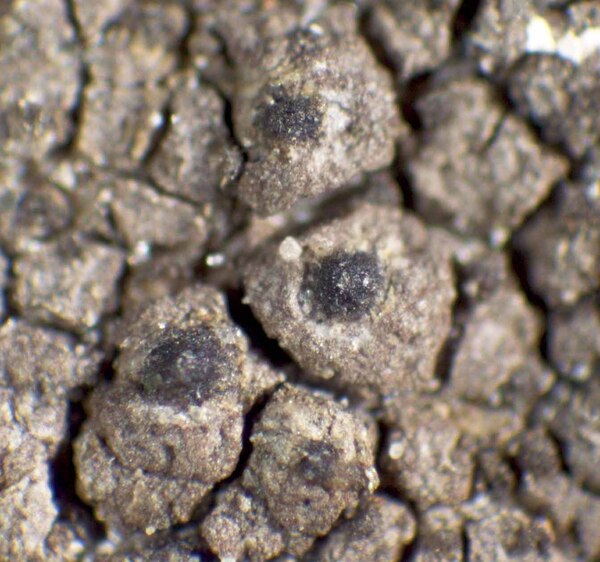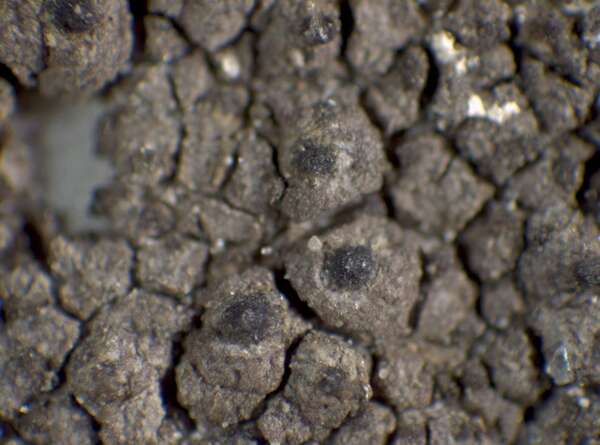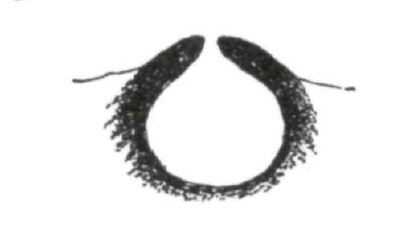Verrucaria transiliens (Arnold) Lettau
Hedwigia, 52: 89, 1912. Basionym: Amphoridium transiliens Arnold - Denkschr. kgl. bayer. bot. Ges., 6: 42, 1890.
Synonyms:
Distribution: N - Frl (Breuss 2008), TAA (Herb. Nascimbene 1658), Piem, Lig. C - Umb (Herb. Ravera 2084).
Description: Thallus crustose, hemiendosubstratic to very thinly episubstratic, whitish grey, pale brown or dark grey-brown, when well-developed finely rimose to minutely areolate. Perithecia black, to 150/cm², ½-¾ immersed, the apical part projecting, 0.3-0.5 mm across, slightly conical with somehow flattened top to almost hemispherical, the flanks covered with a thin, whitish-farinose thalline layer. Involucrellum surrounding almost completely the exciple, but thinner in lower part, laterally 50-80 μm thick, unsharply delimited and often fringed-eroded in outer part; exciple globose, 0.27-0.4 mm across, the wall dark brown and difficult to separate from the closely adpressed involucrellum; hamathecium of 30-40 μm long periphyses and periphysoids, interascal filaments absent; hymenial gel hemiamyloid, I+ red (I+ blue at very low concentrations of I), K/I+ blue. Asci 8-spored, clavate, I-, fissitunicate, the wall thickened above, with an ocular chamber, dehiscent by extrusion of an endotunica to form a delicate rostrum, Verrucaria-type. Ascospores 1-celled, hyaline, ellipsoid, (22-)24-31(-33) x 12-16 μm. Photobiont chlorococcoid. Spot tests: K-, C-, KC-, P-, UV-. Chemistry: without lichen substances.
Note: on calcareous pebbles (e.g. on calciferous sandstone) near the ground, especially in clearings of woodlands and on track sides; probably more widespread, having being overlooked, or confused with similar species. For further details see Breuss (2004).
Growth form: Crustose
Substrata: rocks
Photobiont: green algae other than Trentepohlia
Reproductive strategy: mainly sexual
Commonnes-rarity: (info)
Alpine belt: absent
Subalpine belt: absent
Oromediterranean belt: absent
Montane belt: very rare
Submediterranean belt: very rare
Padanian area: extremely rare
Humid submediterranean belt: very rare
Humid mediterranean belt: absent
Dry mediterranean belt: absent

Predictive model
Herbarium samples
Growth form: Crustose
Substrata: rocks
Photobiont: green algae other than Trentepohlia
Reproductive strategy: mainly sexual
Commonnes-rarity: (info)
Alpine belt: absent
Subalpine belt: absent
Oromediterranean belt: absent
Montane belt: very rare
Submediterranean belt: very rare
Padanian area: extremely rare
Humid submediterranean belt: very rare
Humid mediterranean belt: absent
Dry mediterranean belt: absent

Predictive model
| Herbarium samples |
 Index Fungorum
Index Fungorum
 GBIF
GBIF





